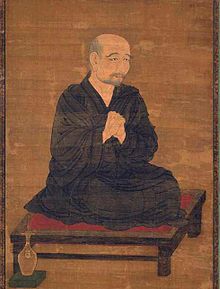Amoghavajra


Amoghavajra (Sanskrit: अमोघवज्र Amoghavajra; Chinese: 不空; pinyin: Bùkōng; Japanese: Fukū; Korean: 불공; Vietnamese: Bất Không, 705–774) was a prolific translator who became one of the most politically powerful Buddhist monks in Chinese history and is acknowledged as one of the Eight Patriarchs of the Doctrine in Shingon Buddhism.
Life
[edit]There are differing views as to where Amoghavajra's origins were from.[1] Zhao Qian states that Amoghavajra was born in Samarkand[2] of an Indian merchant or Brahmin father as according to Feixis's Stele Inscription and a mother of Sogdian origin.[2][3] Yan Ying referred to Amoghavajra simply as being "a person of the Western Regions".[1] Alternatively, Quan Deyu's image hall stele inscription states that Amoghavajra was from Sri Lanka. Yuanzhao also repeats the claim that Amoghavajra was from Sri Lanka.[1]
Amoghavajra went to China at the age of ten after his father's death. In 719, he was ordained into the sangha by Vajrabodhi and became his disciple. After all foreign monks were expelled from China in 741, he and some associates went on a pilgrimage to gather texts, visiting Sri Lanka, Indochina and India. During this voyage, he apparently met Nagabodhi, Vajrabodhi's master, and studied the Tattvasaṃgraha Tantra at length. He returned to China in 746 with some five hundred volumes gathered from Sri Lanka.
In 750, he left the court to join the military governorship of General Geshu Han of the Tang dynasty, for whom he conducted large-scale tantric initiations at his field headquarters. In 754, he translated the first portion of the Tattvasaṃgraha Tantra texts (Taishō Tripiṭaka. 865), central to the Outer Tantras of Vajrayana Buddhism, which became one of his most significant accomplishments. He regarded its teachings as the most effective method for attaining enlightenment yet devised, and incorporated its basic schema in a number of writings.
Amoghavajra was captured during the An Lushan Rebellion but in 757 was freed by loyalist forces, whereupon he performed rites to purify the capital and consolidate the security of the Tang state. Two years later, he initiated the emperor Emperor Suzong of Tang as a chakravartin.
Amoghavajra assisted the Tang dynasty state against the An Lushan rebellion. He carried out Vajrayana rituals which were ostensibly effective in supernaturally attacking and destroying An Lushan's army including the death of one of An Lushan's generals, Zhou Zhiguang.[4][5]
In 765, Amoghavajra used his new rendition of the Humane King Sutra in an elaborate ritual to counter the advance of a 200,000-strong army of Tibetan and Uyghurs which was poised to invade Chang'an. Its leader, Pugu Huai'en, dropped dead in camp and his forces dispersed.
The opulent Jinge Temple on Mount Wutai was completed in 767, a pet project of Amoghavajra, one of his many efforts to promote the bodhisattva Mañjuśrī as the protector of China. Amoghavajra continued to perform rites to avert disaster at the request of Emperor Daizong of Tang.
On his death in 774, three days of mourning were officially declared, and he posthumously received various exalted titles. The Chinese monks Huilang, Huiguo and Huilin[3]: 145, 147, 274 were among his most prominent successors. Seventy-seven texts were translated by Amoghavajra according to his own account, though many more, including original compositions, are ascribed to him in the Chinese canons.
References
[edit]- ^ a b c Goble, Geoffrey (2021). "Amoghavajra". Brill's Encyclopedia of Buddhism Online. doi:10.1163/2467-9666_enbo_COM_2087.
- ^ a b Lehnert, Martin (2010). Esoteric Buddhism and the Tantras in East Asia. Brill. p. 351. ISBN 9789004204010.
- ^ a b Yang, Zeng (2010). A Biographical Study on Bukong 不空 (aka. Amoghavajra, 705-774) : Networks, Institutions, and Identities (Thesis). University of British Columbia. p. 23. doi:10.14288/1.0363332.
- ^ Acri, Andrea (2016). Esoteric Buddhism in Mediaeval Maritime Asia: Networks of Masters, Texts, Icons. Vol. 27 of Nalanda-Sriwijaya series. ISEAS-Yusof Ishak Institute. p. 137. ISBN 978-9814695084.
- ^ Sundberg, Jeffrey (2018). "Appreciation of Relics, Stupas, and Relic Stupas in Eighth Century Esoteric Buddhism: Taisho Tripitaka Texts and Archaeological Residues in Guhya Lanka_Part 2". The Indian International Journal of Buddhist Studies. 19: 211, 230.
Further reading
[edit]- Astley, Ian (1987). The Rishukyo, a translation and commentary in the light of modern Japanese scholarship, PhD thesis, The University of Leeds
External links
[edit]- Digital Dictionary of Buddhism (log in with userID "guest")
- A review of Chinese Esoteric Buddhism: Amoghavajra and the Ruling Elite Archived 2016-04-01 at the Wayback Machine, by Geoffrey C. Goble
- 8th-century Buddhist monks
- Chinese Buddhists
- Tang dynasty Buddhists
- 705 births
- 774 deaths
- Tang dynasty Buddhist monks
- Tang dynasty translators
- Indian emigrants to China
- Shingon Buddhism
- Buddhist translators
- Vajrayana Buddhists
- 8th-century translators
- Buddhist monks from the Western Regions
- Sanskrit–Chinese translators
